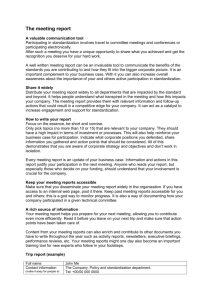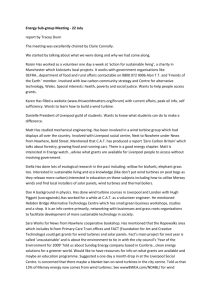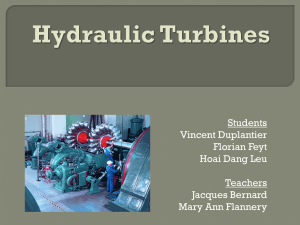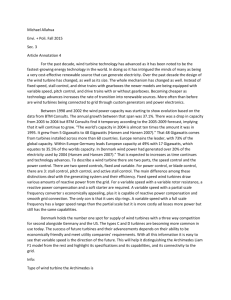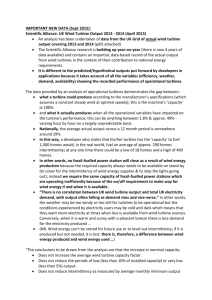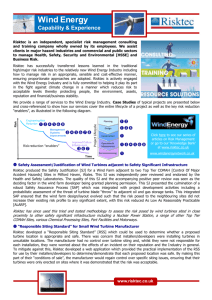Wind Turbine Wind Design Competition
advertisement
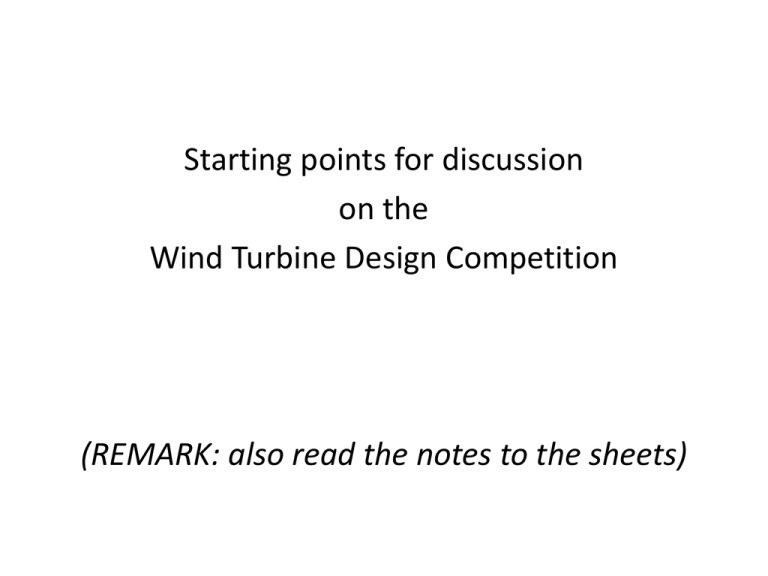
Starting points for discussion on the Wind Turbine Design Competition (REMARK: also read the notes to the sheets) Small windturbines Problem Potential of small wind turbines is not utilized despite of their application and flexibility w.r.t. implementation. Reasons Quality backlog • Disappointing Performance (efficiency, reliability) • High specific price Knowledge gap • Difficult to compare performance between turbines • Problems with yield predictions in different (local) wind conditions • About potential and possibilities for integration (part of the) solution • Quality improvement (efficiency, cost, reliability) and innovation • Increase knowledge base (performance data and comparability, predictability of energy production, operational experience, requirements for acceptance) Wind Turbine Design Competition, PLAN Goal • Innovation and education by international design competition for small wind turbines • Qualitative improvement of knowledge base by testing and operation experience • Quantitative improvement by performance measurements and monitoring (data base) Cooperation with FORWIND, UAS Bremerhaven, UAS Kiel, (InHolland?) Description • competition between student teams in the design, manufacturing and commissioning of small wind turbines Deliverables • working turbine, design report, manual, commissioning report, presentations Requirements • Compliance with standards (or selected articles) • Dimensions of turbines TBD (diameter <1.5m) • Design for a specified wind climate Wind Turbine Design Competition: APPROACH Each institute may submit up to two turbines for the competition Grid connected? no further restrictions to the chosen concept Design for a wind climate typical for small wind turbines Project driven by the student teams themselves Planning • Duration 1 year / yearly organized • Detailed design, production and testing in 1st, 2nd and 3rd semester • Submission to the competition: beginning of June • Jury evaluation and award ceremony during symposium in July Wind Turbine Design Competition: EDUCATIONAL ASPECTS Technical skills • Aerodynamics. • Energy conversion, • Control & safety system, • Structure and loads • Compliance with standards • Grid integration • Environmental aspects • Production • Commissioning / availability / troubleshooting • Technical report and drawings, • User manual & PR leaflet • Working in teams and project organization Other • International cooperation / competition • Knowledge exchange on symposium • “Commercial” presentation on fair Wind Turbine Design Competition: EVALUATION CRITERIA Innovation: • Design features (methods for energy conversion, grid connection, control, safety system, structure, reliability and O&M solutions) • Production (suitable for mass production, number of parts, productions steps or actions) • Environmental aspects (material and energy use, cradle to cradle) • Visual appearance and acceptance, integration (integration in built environment, buildings) Quality • Energy production in specified wind climate • Energy pay back time • Reliability and O&M solutions • Design report and drawings, manual • Presentation on symposium / fair Evaluation by a jury (teachers, specialists and others) based on product assessment, design report, commissioning report, measurements) Wind Turbine Design Competition: TO BE DETERMINED • • • • • • • • The plan Wind turbines: size?, grid connected or not?, compliance with standards? Participation (invitations to other institutes?) Contact persons for the organization Agenda, planning Final ceremony: activities, prizes, date, jury,… What are the IEC requirements for small wind turbines? ……….. NHL approach, followed in 2012 • 2nd year / no basics in fluent mechanics yet • Preparation course: – – – – Explanation on P-V, wind climate, energy production Cp-lambda for different WT concepts from literature Starting points: wind climate / dimensions / safety requirements Load dimensioning (generator design & testing) • Fabrication and assembly • Commisioning • Testing Comment Peter Schaffarczyk, UAS Kiel, • Criterium for evaluation: use highest energy production in moderate V claimate and high σ • Let students also make a “begroting”: production hours, planning, costs (education: compromises must be made, $ is limited) • Compare with formula “student competitions” • Use low voltage: safety, education (instead of buying black box) • Hmax< 10m • Likes measurement on a car. • Study cv = strict, little flexibilityct NL • 8-10 credits for this project (30 in a semester) Comment Stephan Barth, Michael Holling, FORWIND • Prefers testing in wind tunnel over testing on a driven platform (ref Andrea Reuter: WT on Volvo = unreliable/ permission only for GB based industry) • Suggests DLR wind tunnel or 2x2m wt in Varel van Deutsche Wind Gard (of een grote wt in Wilhelmshaven?) • 1 year is too little time for this project (not real) • No problem with participating at a later stage • KISS in the beginning of the project • Safety = important – Ask for evidence of max loads and RPM – Comply with simplified load assumptions – “certification committe: ask GH • E is maost important criterium. To be measured in wind tunnel (ramp V test performance and quality of control and safety system) Comment Henry Seifert, UAS Bremerhaven • • • Important: 1 robustness, 2 robustness, 3 robustness, bremerhaven has an airstrip that will be closed next year: good runway for driven platform Safety = important – Comply with simplified load assumptions to be determined by “certification body”, oa Vmax – invite industry (jury, material sponsors, • • • • • Specify the measurement system Duration? 1 or 1.5 year for complete program. High workload for students, they will complain Planning: specification, design with certification report, evaluation report and go/nogo, production, commisisoning, measuring, symposium. Up to and including certif report: 25 credits, rest 5 credits Blade testing acc to IEC defined by commission




